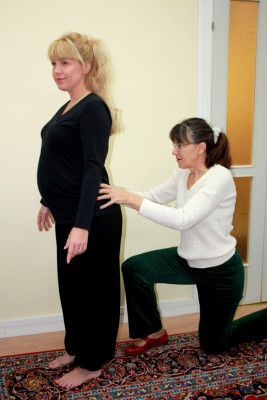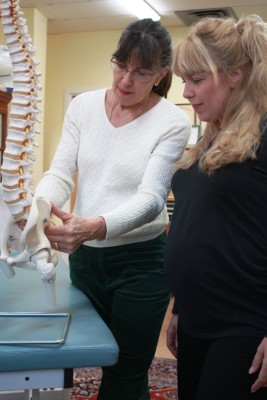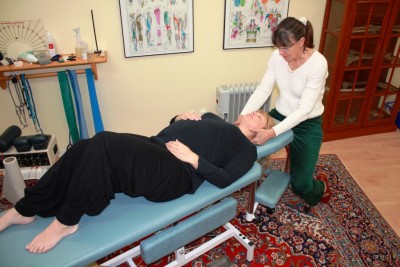 |
 |
 |
 |
Chiropractic Care for the Pregnant Patient
Det inga restriktioner för en Leg. Kiropraktor att behandla gravida, men man ska välja en Kiropraktor som har utbildat sig vidare i området (pregnant patient). I Sverige, har Sue Weber längst utbildning och mest erfarenhet när det gäller undersökning, diagnostik (vad är problemet) samt behandling av gravida och barn. Sue utbildar andra kiropraktorer i undersökning, diagnostik och behandling av både gravida och barn i alla åldrar. Både gravida och barn har problem som skiljer sig från vanlig vuxna, därför behövs det specialister som har vidare utbildning. Det handlar om säkerhet, att förstå när patienten behöver eventuellt annan akut vård.
Forskningsresultat visar att behandling av den gravida kvinnans rygg och bäcken minskade smärtan från rygg, bäcken och ben. Med sin höga kompetens i rörelseapparatens funktion kunde kiropraktorn komma fram till vad som orsakade dessa besvär. De gravida patienterna med besvär från rygg och bäcken fick en behandling som var anpassad till deras gravida tillstånd med resultatet att de upplevde mindre besvär samt fick bättre rörlighet.
Studier i USA har visat att behandling av gravida minskar sjukskrivningar och att dessa kvinnor är mer aktiv och mår bättre under graviditeten. Behandling för den gravida kvinnan är mjuk och är helt ofarlig för fostret. Den kiropraktiska behandlingen är inte bara för lederna, ligamenten och muskler, det ingår även råd om lämpliga övningar för att stabilisera kroppen, ergonomi på jobbet, näring och kost råd för den blivande mamman.
Pregnancy and Chiropractic Care
Pregnancy causes a temporary dynamic change in the biomechanics of the human body. Smaller problems that may have been latent may become evident and bothersome as the body changes and develops. The increasing weight of the abdomen and breasts change the curves of the back and neck. The ligamentous system is affected making joints more mobile and less stable. This combination can create problems for some women, particularly those that have had previous problems with their back or neck.
Women who have back pain prior to pregnancy may experience greater pain during pregnancy. This complicates daily activities and increases the risk for sick leave. Pregnant women with back pain not uncommonly feel quite hindered in caring for other young siblings. Adequate skills in diagnosis are critical to receiving appropriate care and guidance through pregnancy. The primary care system which is geared to save lives lacks complete training in musculoskeletal health. Chiropractors with a specialty in treating the pregnant patient are trained to examine and safely treat the pregnant patient.
The uterus is where the fetus grows and develops. It fastens with ligaments to different parts of the pelvis both in the front and in the back. The pelvis forms a ring with 3 different bones which come together acting as a support for the spine and form a unit for the hips to fasten in. Women who have back pain, groin, pelvic or leg pain can develop a temporary torque in the pelvis, affecting the lie of the uterus. When the pelvis is torqued, one or both of the round ligaments are affected causing pain and discomfort in the lower abdomen. This is commonly treated by the chiropractor specializing in the care of the pregnant patient. The torqueing can affect the lie of the uterus, so the developing fetus is constrained. Appropriate treatment reducing the torqueing can reduce constraint for the developing fetus so they can achieve a more optimal positioning. The Webster technique and Rebozo techiques are used for this purpose. Webster technique for the breech baby (sätesbjudning). This is the strategy with treatment allowing the fetus in a breech or transverse lie come around. The rebozo techniques and spinning baby exercises can be used by parents both before and during delivey to help the baby position itself more optimally to reduce the risk for intervention. Chiropractic treatment of the pregnant patient for optimal fetal positioning. If the infant has a suboptimal position at the start of delivery, (and this can even be that the head is tilted), labor will be delayed. When labor is delayed there is a higher chance of intervention which increases the risk for injury for both the mother and the infant. Treatment of the pregnant patient with this type of torqueing can not only reduce pain and disability, but help to make the delivery quicker and safer.
Besides pelvic problems, it is common for the pregnant woman to experience mechanical problems with the thoracic spine and rib cage. This must accommodate the growing fetus and postural changes create mechanical stress in this area which respond well to treatment.
Those patients with neck problems can experience exacerbations due to a more forward head posture as the breasts and abdomen enlarge. Treatment of the pregnant patient varies from other adults due to the physiological changes in the body. It should be gentler and take consideration for these changes.
Women in the perinatal period are at a higher risk for stroke, particularly postpartum. The risk for stroke is elevated with certain conditions, particularly in those who get high blood pressure and those who are obese. The following article outlines common risks for stroke and recommendations for safe treatment. Weber-stroke risk pregnancy
D-vitamin brist hos den gravida kvinnan påverkar fostrets framtida hälsa
The infants D vitamin status is dependent on the mothers D vitamin status at birth. The pregnant mother with vitamin D deficiency will have an infant that is deficient in D vitamin. This is particularly a problem for infants born in the spring. Low infant levels are associated with increased risk for a number of illnesses including the RS virus, asthma and diabetes 1 later in life. Besides supplementing the infant, the pregnant woman and breastfeeding mother are recommended to take a dose of 4000 IU so the fetus/infant gets adequate levels.
The neglected pregnant patient
The Swedish pregnant patient with pain between the navel and the knees is dismissed with the back of the hand as having temporary hormonal changes that cause pain in the pelvis. Read more
Chiropractic care of the pregnant patient starts before the woman is actually pregnant
Nutrition is a cornerstone of our education and plays a role in our management of patients. An important aspect of optimal health for patients has to do with nutrition. Fertility of both the man and the woman is affected by suboptimal nutrition with a common cause of infertility (even in Sweden) being a deficiency in both vitamins and minerals.
The nutritional status of the mother to be plays a critical role in how the developing fetus is programmed to develop. This concept is called epigenesis and it relates to how the prenatal environment can predispose the fetus to conditions later in life. Nutritional needs change during pregnancy and optimal fetal health depends on maintaining adequate levels of vitamins and minerals.
The vast majority of pregnant women experience low back pain or pelvic pain. It is the most common cause of sick leave in the Scandinavian countries. Despite this, care givers seldom examine women to determine the cause of pain and disability, nor do they refer the patient for care. It is assumed that this is a natural part of the pregnancy which is relieved with birth. Most of the pain syndromes experienced during pregnancy can be diagnosed and effectively treated allowing women to function normally without pain at home and at work. Because the uterus is suspended from the pelvic girdle, problems with the pelvis may affect the developing fetus. Pelvic obliquity affects fetal positioning. The risk for intervention increases dramatically when the fetus is unable to position itself optimally prior to delivery. Intervention increases risk for harm to both the mother and infant, and is a common cause of pain and torticollis in the infant.
Considering the enormous changes to the body, particularly the increase in size and change in biomechanics, it is not surprising that many women experience pain. The posture changes dramatically to compensate for the enlarging abdomen and breasts. The low back is a pivotal point which takes on a large part of the load as center of gravity shifts. The mechanics of the body change, so there is stress on the upper back and neck as well.
Chiropractors are specialists in biomechanical health, how the joints function optimally and how muscles accommodate to changes in joint functioning. The pregnant patient undergoes a series of changes not only in the pelvic girdle and low back, but also in the functioning of the legs and feet, the ribcage and even head positioning. The hormonal changes affect the ligaments, the tissue holding the joints together, adding to the risk for instability to an already overloaded system.
An important aspect of care for the pregnant patient is having an understanding of the biomechanical changes that occur as well as what is optimal positioning for the fetus and how deviations from this affect both the mother and the developing fetus. Special skills are required for safe treatment of the pregnant patient and the developing fetus. Techniques are gentle but effectively restore normal function to affected joints, muscles and ligaments.
Spinal Manipulative Therapy deemed safe and effective for lumbar and pelvic pain on pregnancy in British Medical Journal
Low back pain is a common musculoskeletal symptom in pregnancy that can present as lumbar pain or pelvic girdle pain, with significant physical and psychosocial implications. Pelvic girdle pain is more prevalent and results in greater disability than lumbar pain. It is possible to distinguish between these two conditions from a detailed history based on the site of the pain, its intensity, disability and pain provocation tests. Management of low back and pelvic pain in pregnancy is conservative: for lumbar pain physical exercise is individualized while simultaneously minimizing activities that exacerbate pain, gentle manipulative techniques designed for the pregnant patient have good effect and are considered safe; for pelvic girdle pain, analgesics and bed rest pain are sometimes required. It is important to avoid abduction beyond the pain-free zone. There is evidence that gentle spinal manipulative therapy and pelvic belts can improve function in Daily Life. Stabilising exercises in patients with pelvic girdle pain postpartum have a beneficial effect. Other treatment modalities that have been shown to be safe and effective include pelvic belts, transcutaneous electrical nerve stimulation, spinal manipulative therapy, acupuncture and complementary therapy with yoga. Other orthopaedic complications in pregnancy such as carpal tunnel syndrome, pubic symphysis rupture, transient osteoporosis and osteonecrosis are usually self-limiting with a satisfactory outcome. However, a lack of awareness and failure to recognise these complications can result in long-term morbidity. Swedish studies have demonstrated that persistent pregnancy related lowback pain and pelvic girdle pain is a major individual and public health issue among women 14 months postpartum, negatively affecting their self-reported Health. Read article here>. Further Swedish studies indicate that pregnant women with lowback pain and/or pelvic girlde pain should be addressed early in pregnancy to reduce both individual suffering and the risk of transition into chronicity.Read article here>. The Swiss have studied specifically chiropractic treatment of the pregnant patient with lowback pain and found that most pregnant patients undergoing chiropractic treatment reported clinically relevant improvement at all time points.Read article here>.
Vanliga funderingar:
Kan man behandla den gravida kvinnan med kiropraktik?
Under graviditeten har kvinnan en ökad risk att drabbas av mekaniska problem som kan vara smärtsamma och hindrar henne från normala aktiviteter. Behandling hos en kiropraktor (legitimerad och med godkänd utbildning) som har kompetens att behandla den gravida kvinnan är helt ofarlig. Man använder mjukare tekniker och tar hänsyn till båda fostret och mamman. Eftersom kroppen ändrar sig så dramatiskt under denna tid, mår kvinnorna normalt väldigt bra av behandling och kan fortsätta längre in i graviditeten med sitt arbete och vardagliga aktiviteter.
Varför får gravida ont i ryggen eller bäckenet (foglossning eller bäckenuppluckring)?
Många kvinnor får besvär med bäckenet och ryggen under graviditeten. Det vanligaste är att en gravid kvinna med ont i ryggen eller bäckenet får diagnos bäckenuppluckring eller foglossning utan någon närmare undersökning. Det finns många fler orsaker till besvär i rygg o bäcken än dessa två. Den gravida kvinnans rygg och bäcken är utsatta för en kraftigt ökad mekanisk påfrestning under denna period. Magen och brösten växer och blir att tyngre samtidigt som ligament systemet påverkas och blir mjukare, vilket gör att lederna blir rörligare än tidigare. Det är väldigt vanligt att problemen med bäckenet och ryggen under graviditeten har ett mekaniskt ursprung och de flesta kan behandlas framgångsrikt med kiropraktik. Det är också vanligt med besvär i bröstrygg, nacke o fötter som är av mekaniskt ursprung under graviditeten. Kiropraktorn behandlar lederna i fötterna, knäna och höfterna, detta gör att hela mekaniska kedjan fungerar bättre.
Hur ska man träna under graviditeten om man har haft ont i ryggen?
Den gravida kvinnan kan träna gärna övningar från de program vi har på hem sidan (Rehab)
Referenser:
Weber S. 2020. A risk too great? Stroke implications with manual therapy for the pregnant patient: A scoping review. 19(2)1688-1693.
Bergström C, Persson M and Mogren I. 2016. Sick leave and healthcare utilisation in women reporting pregnancy related low back pain and/or pelvic girdle pain at 14 months postpartum. Chiropractic & Manual Therapies;24:7 DOI 10.1186/s12998-016-0088-9
Bergström C, Persson M, Mogren I. 2014 Pregnancy-related low back pain and pelvic girdle pain approximately 14 months after pregnancy – pain status, self-rated health and family situation. BMC Pregnancy and Childbirth;14:48 http://www.biomedcentral.com/1471-2393/14/48.
Peterson C, Mühlemann D, Humphreys K. 2014. Outcomes of pregnant patients with low back pain undergoing chiropractic treatment: a prospective cohort study with short term, medium term and 1 year follow-up. Chiropr Man Therap;22: 15. Published online 2014 Apr 1. doi: 10.1186/2045-709X-22-15. PMCID: PMC3994225
Murphy D, Hurwitz E, Mc Govern E. (2009). Outcome of Pregnancy-Related Lumbopelvic Pain Treated According to a Diagnosis-Based Decision Rule: A Prospective Observational Cohort Study. JMPT;32(8)616-24.
Lisi AJ. (2006). Chiropractic spinal manipulation for low back pain of pregnancy: a retrospective case series. J Midwifery Women’s Health;51:e7–e10.
Andrew C, Pedersen P. (2003). A study into the effectiveness of chiropractic treatment for pre- and postpartum women with symphysis pubis dysfunction. Eur J Chiropract ;48: 77–95.
Borggren CL. (2007). Pregnancy and chiropractic: a narrative review of the literature. J Chiropr Med;6:70–74.
Daly JM, Frame PS, Rapoza PA. (1991). Sacroiliac subluxation: a common treatable cause of low-back pain in pregnancy. Fam Pract Res J;11:149–159.
Fallon J. (1996). Chiropractic manipulation in the treatment of costovertebral joint dysfunction with resultant intercostal neuralgia during pregnancy. J Neuromusculoskeletal Syst;4:73–75.
Kruse RA, Gudavalli S, Cambron J. (2007). Chiropractic treatment of a pregnant patient with lumbar radiculopathy. J Chiropr Med;6:153–8.
McIntyre IN, Broadhurst NA. (1996). Effective treatment of low back pain in pregnancy. Aust Fam Physician;25(suppl 2):S65–S67.
Stuber KJ, Smith DL.(2008). Chiropractic treatment of pregnancy related low back pain: a systematic review of the evidence. J Manipulative Physiol Ther;31:447–454.
Stuber K.(2007). The safety of chiropractic during pregnancy: a pilot e-mail survey of chiropractors’ opinions. Clin Chiropr;10:24–35.
Stern P, Cote P, O’Conner S, et al. (1993). Symphysis pubis diastasis: a complication of pregnancy. JNMS;1:74–78.
Khorsan R, Hawk C, Lisi A. (2009). Manipulative therapy for pregnancy related conditions. JMPT;64(6)416-427.
Bhardwaj A, Nagandla K. Postgrad Med J. 2014 Aug;90(1066):450-60. doi: 10.1136/postgradmedj-2013-132377. Spinal Manipulative Therapy deemed safe and effective for lumbar and pelvic pain on pregnancy in British Medical Journal.
Gnoli M, Brizola E, Tremosini M, Di Cecco A, Sangiorgi L. Vitamin D and Bone fragility in Individuals with Osteogenesis Imperfecta: A Scoping Review. Int J Mol Sci. 2023 May 28;24(11):9416. doi: 10.3390/ijms24119416. PMID: 37298368; PMCID: PMC10253769.
Topak D, Seyithanoğlu M, Doğar F, Karadeniz AA, Tanrıverdi B, Ozan F, Bilal Ö. Are vitamin D and vitamin D receptor levels different in children with developmental dysplasia of the hip? J Orthop Surg Res. 2021 Jan 7;16(1):24. doi: 10.1186/s13018-020-02162-y. PMID: 33413534; PMCID: PMC7791744.
Miller-Loncar C, Bigsby R, High P, Wallach M, Lester B. 2013. Infant colic and feeding difficulties. Arch Dis Child 2004;89:908–912. doi: 10.1136/adc.2003.033233.